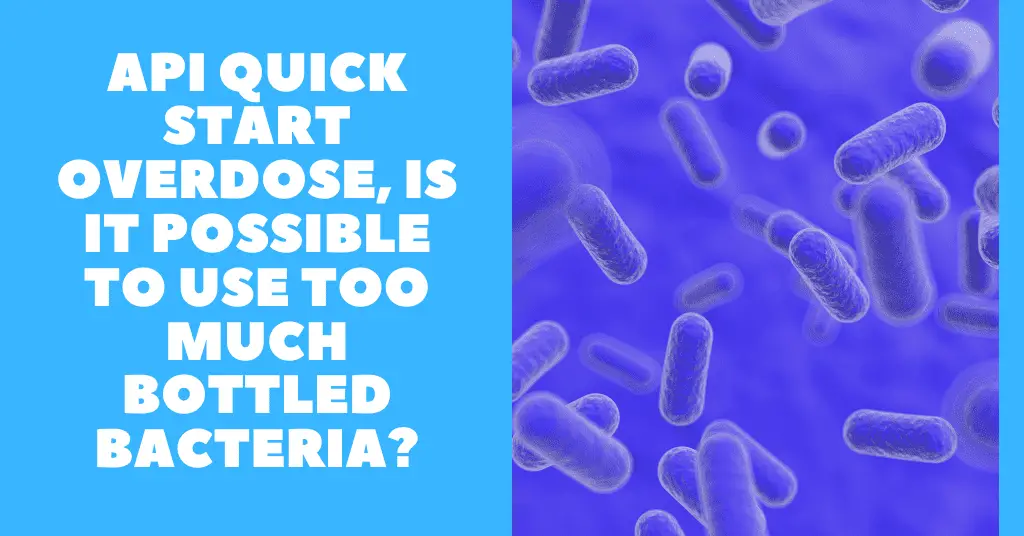Last Updated on July 24, 2021 by cmoarz
It can be a real bummer waiting 4+ weeks for a new aquarium to break into a new cycle. It’s long and tedious work and that whole time you can’t really add any fish without the risk of killing them from ammonia spikes.
So we all get excited when we first learn about API quick start, nutrafin cycle, Nitromax marine, and other bottled bacterias that promise to speed up the cycling process.
But how much is too much?
Table of Contents
The answer is, API quick start overdose just doesn’t happen. None of the quick-start bottled bacteria brands will cause an overdose in your new tank no matter how much you use. The same can be said for dechlorinator and stress coat chemicals.
Hopefully, that put’s your mind at ease when it comes to using these products. They’re perfectly safe and effective.
Common misconceptions and myths I often hear people say
- “The amount of quick start I use will determine how quickly my new aquarium cycles”
- “API Quick Start Overdose Is Possible “
- “If the bottled bacteria makes it into my tank, then there’ll be an overdose and everything will die”
The truth is, none of these are true. Only good things will happen when you’re adding extra beneficial bacteria to a new tank.
But I added an entire bottle and it’s still not working?
You have to remember how these bacterias work. They eat ammonia and convert it to nitrites and in turn, convert the nitrites into nitrates. But without a source of ammonia in the tank, there is nothing to kick start the cycle no matter how much bacteria you use.
When doing a fishless cycle, you will need to add some sort of bioload to the tank to boot up the process. Liquid ammonia can often be used or place in fish food in the empty tank to let it break down.
If you aren’t doing a fishless cycle, be sure that you are using a hearty fish so that it can survive any random water chemistry changes that the cycle will bring.
Some strong hardy fish include:
- Minnows (danios)
- Snails
- Nonfancy guppies
- Corydoras
- Tetras
- Labyrinth fish
- Gouramis
- Paradisefish
- Pupfish
You will also find people use goldfish as tank fodder, Although fairly hardy, I don’t recommend them nearly as much. Assuming they survive, you now have a goldfish that’s going to grow into a giant, and unless you are prepared for that, goldfish are always a bad idea.
What about a water conditioner and stress coat chemicals?
You definitely can’t overdose your aquarium on these either.
Dechlorinator for example should be used every time you do a water change, preferably before that water ever enters the tank so the nitrifying bacteria that live in the filter aren’t killed on contact with unconditioned water.
Many of us like to use a double dose when adding new fish. This helps the stress coat elements that are normally present in tap water but couldn’t make it into your tank before the water enters by giving them an extra kick start.
So why do my fish die after I use it?
It’s most likely completely coincidental. Having fish in a cycling tank is always risky. When starting a new tank, Ammonia and nitrite levels will often go through the roof in the first 2 weeks. You may even smell how powerful the ammonia is if you standing close to your tank.
The bacteria is doing its job, but the spike needs to happen for the bacteria to multiply. The more bottled bacteria you use the faster this spike will go away.
But that doesn’t mean it won’t be there at all, And any ammonia or nitrite spike can kill fish if concentrated enough and the species of fish is not hard and hearty.
Fyi, Snails are a really good choice for cycling tanks. They are super sturdy and have a huge bioload. When the water gets too bad and they close themselves up, it’s time to start doing water changes every day.
- Don’t worry, water changes won’t slow down the cycling process very much.
Summary
A quick-start overdose is not possible, even if you use an entire bottle of bacteria there will be no harmful effects on your aquarium. Fishless cycling with live food or liquid ammonia, and hearty fish will always help accelerate that process. Do note that dechlorinator should be used every time you do a water change so as not to kill off any nitrifying bacteria needed to cycle your tank for you.
About
Owner of AquariumGravel.com and also owner of actual Aquarium Gravel believe it or not! ;). Setting up beautiful aquarium sceneries and habitats since I was very young. Enjoy!
- Web |
- More Posts(290)

